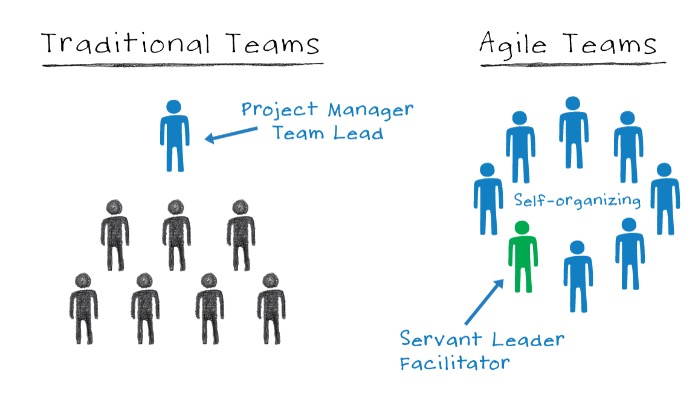Structuring Scrum Teams – II
ADVANTAGES OF SMALL TEAMS
On the other hand, there are more advantages of small teams:
There is less social loafing. Social loafing is the tendency for people to exert less effort when they believe there are others who will pick up the slack. Members of small teams are less prone to social loafing. Studies have shown that individual effort is inversely related to team size (Stangor 2004, 220).
Constructive interaction is more likely to occur on a small team. Constructive interaction and constructive conflict start with team members getting to know and trust each other. For this to happen, inter-individual interaction should be formed within the team. Team spirit and team identity, goals and responsibilities can be achieved when all team members have a good communication and interaction. Studies show that teams of more than 10 to 12 people have a difficult time establishing feelings of trust, mutual accountability, and cohesiveness.
Less time is spent coordinating effort. Small teams spend less time coordinating the efforts of team members. This is true both in the aggregate and as a percentage of total project time. We all know that planning a meeting for a large team can be overwhelming.
No one can fade into the background. In large teams, there is lower participation in group activities and discussions. Similarly, the disparity in the amount of participation among team members increases. The problems can prevent a group of individuals from becoming a high-performing team.
Small teams are more satisfying to their members. In a small team, one person’s contributions are more visible and meaningful. This is perhaps one reason why research has shown that participation in a large team is less satisfying to team members (Steiner 1972).
Harmful over-specialization is less likely to occur. On a large project, individuals are more likely to take on distinct roles. For example, one developer chooses to work only on the front-end jobs. This creates wasteful hand-offs of work between team members and reduces the amount of learning that occurs when individuals are more willing and likely to work beyond specific job roles.
One interesting study of team size looked at 109 different teams. The small teams had 4 to 9 members while the large teams had 14 to 19. The researchers reached the following conclusions:
“Members of smaller teams participated more actively on their team; were more committed to their team; were more aware of the goals of the team; were better acquainted with other team members’ personalities, work roles, and communication styles; and reported higher levels of rapport. The data also show that larger teams are more conscientious in preparing meeting agendas compared to smaller teams. (Bradner, Mark, and Hertel 2003, 7)
The study also shows that large teams need a lot of preparation to be able to make a good meeting. In other words, as we have mentioned previously, small teams do not need to prepare for a meeting for a long time because they spend less time coordinating effort.
The only advantage of a larger team is better meeting agendas.
Small Team Productivity


Given the strength of these advantages to small teams, we would expect small teams to be more productive than large teams. Let’s look at the database created by QSM which has been collecting data about software companies since 1978. In the chart above, data from 491 of 7,000 projects are available. QSM has narrowed the data set to 491 projects by limiting them based on lines of source code. When we look at the project data, we see that productivity significantly declined when the team size is higher than 7.

QSM also looked at the total development effort that goes into projects. According to that, small teams complete a project of the same size with the overall development effort of less than 70, while the total effort in large teams is 3 to 10 times higher! You see that the trend here is exponential. So, the big teams are putting more effort to do the same sized job.
Let’s look at the subject in terms of the completion time of the projects, since this is a basic constraint. When we look at the effect of team size in total, we see that teams of 5-7 people completed their projects almost 6 months earlier (up to 68%) compared to teams of 9-11. We can see that the teams with fewer members have finished in a longer time, not because the amount of production per capita was less, but because they had higher amount of jobs as they had fewer people.
CONCLUSION
As we have seen, team size has very serious effects on the results. The disadvantages of large teams are much more than their advantages. In particular, creating a “team spirit” and communication costs is the most serious problem in large teams. Other factors such as the people fading into the background in the group and social loafing affect the team feeling significantly. In large teams; deficiencies such as lack of confidence, fear of positive conflicts, commitment to work and team, avoiding responsibility and indifference are much more common.
As it is stated in the Scrum Guide published by scrum.org, the ideal team size is between 3 and 9 people, and all the data we show above supports this. Dividing up teams with more than 9 people and creating two teams is even more effective than the cost of communication and other problems.
Reference: “Succeeding with Agile: Software Development Using Scrum“, Mike Cohn, The Addison-Wesley Signature Series, 2010







